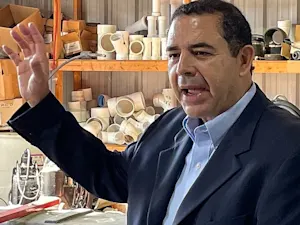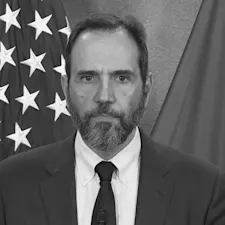Could the Lost Ark of the Covenant Finally Be Found?
Ark of the Covenant replica, Church of Saint-Roch, Chapel of Adoration. Photo by Mbzt under CC BY-SA 3.0.
Could the Lost Ark of the Covenant Finally Have Been Found? Archaeologists at Tel Shiloh in Israel may have reportedly uncovered the original Tabernacle, the sacred structure that once housed the Ark of the Covenant, the golden chest described in the Bible as containing the Ten Commandments. This discovery, if confirmed, could prompt a significant reevaluation of ancient history and shed new light on one of the most enduring mysteries of biblical lore.
Unearthing the Tabernacle at Shiloh
The biblical Ark of the Covenant is shrouded in mystery. According to scripture, Moses placed the Ten Commandments inside this gold-covered chest, which was kept in the Tabernacle — a portable sanctuary built shortly after the Israelites' Exodus from Egypt, traditionally dated by some scholars to around 1445 BC. The Ark vanishes from the biblical record before the Babylonian sack of Jerusalem in 586 BC, leaving its fate unknown.
Now, a team of archaeologists led by Dr. Scott Stripling at the ancient site of Tel Shiloh has reportedly uncovered a "monumental" stone structure that appears to match the biblical description of the Tabernacle, according to Internewscast.com. The building, dating to the Iron I period, is oriented east-west and divided in a 2:1 ratio, just as the Bible describes.
This alignment and proportion are not the only clues. Excavators have also reportedly found over 100,000 animal bones, primarily from sheep, goats, and cattle. Intriguingly, most of these bones come from the right side of the animals, which corresponds with instructions in Leviticus 7 that the right side was reserved for priestly offerings. Pottery shards found alongside the bones reportedly date to the same period, reinforcing the connection to the Tabernacle era, which the Bible says lasted nearly 400 years before the Temple was built in Jerusalem.
Shiloh: Israel's First Religious Center
Located in the hill country of Ephraim, Shiloh is described in the Bible as Israel's first major religious center. It was here that Eli the high priest presided over the Tabernacle during a critical moment in Israel's history. The biblical narrative in 1 Samuel 4 recounts how the Israelites brought the Ark to the battlefield against the Philistines, hoping to secure divine favor. The plan backfired when the Philistines captured the Ark, and Eli's sons were killed. Upon hearing the news, Eli, nearly blind and 98 years old, fell backward from his seat at the city gate, broke his neck, and died. According to EndTimeHeadlines.org, Dr. Stripling's team believes they may have uncovered the very gate where Eli met his end.
The newly discovered building also reportedly features a massive interior wall dividing the space into two areas, reminiscent of the Tabernacle's inner sanctuary, the Holy of Holies, separated by a veil as described in Exodus 26. This inner room was believed to house the Ark and serve as the earthly dwelling place of God's presence. Biblical texts warn of the sanctity of this space, noting that unauthorized entry could result in death.
The CIA's Psychic Search for the Ark
While the archaeological findings at Shiloh are stirring excitement, the mystery of the Ark has also attracted more unconventional investigations. In a recently resurfaced declassified CIA document, the agency claimed to have confirmed the Ark's existence through remote viewing, a form of psychic perception, in 1988. During this session, Remote Viewer #32 described a secret Middle Eastern location guarded by "entities" with "unknown" powers, according to the New York Post. The target was said to be a container fashioned of wood, gold, and silver, decorated with seraphim, and hidden underground in a dark, wet place.
The remote viewer's description included details about the surrounding buildings, mosque domes, and Arabic-speaking men dressed in white. The viewer also warned that the container could only be opened by authorized individuals, adding that "Individuals opening the container by prying or striking are destroyed by the container's protectors through the use of a power unknown to us," as reported by the New York Post. The purpose of the Ark, according to the psychic session, was to "bring people together" through ceremony, memory, and spiritual lessons far beyond current knowledge.
However, skeptics, including legendary "remote viewer #1" Joe McMoneagle, dismissed the CIA's remote viewing exercise as a "waste of time and resources," as reported by the New York Post, emphasizing that no physical evidence was produced to substantiate the claim. McMoneagle noted that remote viewing without ground truth is unreliable and that the Ark remains a legendary tale until proven otherwise. "Currently, the Ark of the Covenant is a legendary tale. If they can produce the actual Ark based on the information, it will be a surprise to me, as well as to many others," he added.
A Holy Drama Unfolding
The convergence of these discoveries and claims creates a compelling narrative that feels ripped from the pages of a biblical thriller. On one hand, the Tel Shiloh excavation offers tangible evidence that aligns eerily well with ancient scripture. On the other, the CIA's psychic probe adds a layer of supernatural intrigue and elite mystique, fueling speculation about secret knowledge and hidden powers.
For centuries, the Ark of the Covenant has captivated imaginations, inspiring tales of divine wrath, miraculous power, and lost treasure. Now, with the possibility that the original Tabernacle has been unearthed and the Ark's location psychically pinpointed, some speculate that we may be on the cusp of rewriting history.
Are we mere weeks away from confirming the Ark's resting place? Will the world finally witness the unveiling of a sacred relic that has eluded discovery for millennia? The answers remain elusive, but the drama is unfolding before our eyes, blending archaeology, scripture, and espionage into a story that demands attention.
As you ponder these revelations, consider the implications. If the Ark is found, it could reshape religious scholarship, ignite global fascination, and challenge our understanding of ancient history. Until then, the mystery endures, inviting believers, skeptics, and thrill-seekers alike to watch closely as this biblical story continues to unfold.
References: Discovery Sheds Light on the Ark of the Covenant Mystery | Ark of the Covenant mystery blown wide open as 'biblical relic' discovered | CIA confirmed Ark of the Covenant's existence using remote viewing, resurfaced declassified docs claim






















